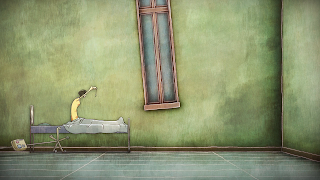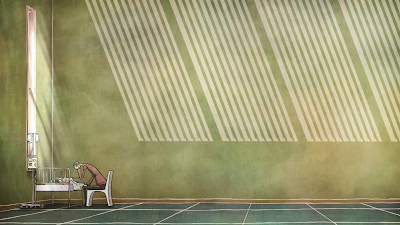De_Riria_Subasutaimu
De_Riria_Subasutaimu is a surreal and abstract short film
about grief. It shows a husband and wife dealing with it in different ways.
Just in case you haven’t watched it yet, here’s the short
film:
The film is specifically about the grief of pregnancy/child
loss. This grief is presented in both a surreal state and a more grounded
manner through parallel storylines of a husband and wife. The surreal is portrayed
through the dreamlike journey of the husband, which is a mix of escapism,
depression and resilience.
Much of the husband’s visual storytelling is consisted of repetitive
and rhythmic imagery. Even the though the journey is abstract, the strong use
of rhythm and repetition organizes the composition. This organized composition
is a visual progression that leads the audience along this dreamlike journey.
The wife’s story is more grounded but not without strong composition.
Since she stays in her hospital room, much of her emotions are expressed by adding,
subtracting, and changing visual information.
Intro
The film begins with a lateral tracking shot that stops at the
above static shot. Immediately the film establishes a melancholic tone. Seeing the
IV bags, the wife lying on the bed and the husband’s sad body language
communicates sorrow quite effectively. The large negative space and the use of ray
of light (from the window) as a leading line isolate the couple and further
accentuate the feeling of sorrow.
The shot above also establishes the use of repetition and rhythm
as evident by the diagonal shafts of light coming from the ceiling. The dynamic
nature of the diagonal line and its repetition aids in the emotional expression
of the shot.
 |
 |
The husband leaves the hospital and the audience gets to follow
him with the use of a tracking shot. The low angle magnifies and emphasizes his
grief as we follow along. He then looks off screen to an empty lot. The
overhead of the empty lot shows just the foundation, made up of randomly sized
rectangles, perhaps symbolizing his jumbled mental state. He then jumps in to
begin his surreal escape from the reality of pregnancy loss.
Stage 1
 |
 |
The first stage of the journey was the simplest one. It’s
consisted of him just walking. I believe this was done to ease the viewers into
the journey without being too jarring. The repetitive images here are the light
bulbs, bottom windows and the terrace steps.
Most of the stages end with a scene of the wife in the hospital
which documents her own process of grief. At the end of the first stage, the
wife wakes up and stares at what can be assumed as an ultrasound picture. The
slow shot reverse shot suggests she’s not aware of their child loss. While she’s
yet to deal with reality, the husband is running away from it.
Stage 2
 |
 |
The second stage is a tower with outside stairs. The wide
shot communicates every necessary visual information, the ominous height, the
steps connection the entrance/exit, the repetition and rhythm.
From here on out almost every stage tempts the husband to
jump into the pit of despair. In this stage it’s symbolized by the dead body in
the middle of the stairway. He avoids it as another step emerges above it.
As mentioned before the journey is a mix of escapism, depression
and resilience. The grim temptations are the depression. The ability to avoid
these temptations is the resilience.
The wife still hasn’t confronted reality yet. The time lapse
shot seems to suggest that she’s just delaying dealing with reality. This notion
is very relevant in the next stage.
Stage 3
 |  |
The husband moves on to a subway platform. He sees a woman
who seems to be in same predicament as he is. A train passes by (repeating
image); he grabs a hold of it while the woman doesn’t. The scene switches to a
low angle shot and the woman is now the wife but she still doesn’t grab hold. The
train symbolizes different things for both. For the husband it’s a way to
escape, which he takes, and for the wife it’s a way to move on. The low angle
accentuates the speed of the train and the wife’s inability to grab hold of
reality and move on.
In this scene, the wife caresses her stomach and finally
realizes the reality of her pregnancy loss. She then collapses in despair. The
scene initially maintains the low angle from the previous train scene; this
angle and the canted angle add more impact to this pivotal point.
Stage 4
 |
 |
The fourth stage is in the woods, populated with black trees
with horizontal white lines as the repetitive imagery. The stage offers him an
escape from this grim environment by leading him on top of a skyscraper, almost
as if tempting him to jump.
The doctor shows up to officially deliver the harrowing
reality. He’s almost portrayed like a grim reaper, a scary embodiment of bad
news. The use of negative space and wide shot to show the slow long walk conveys
a distressing tension. Also notice the far more intense diagonal lights, which complement
the sense of distress.
Stage 5
 |
 |
In this stage he climbs up a wall. The initial lack of
visual information on the right side builds anticipation for the eventuality of
him jumping to that side. What waited for him on the other side was an arm.
Will it grab a hold of him? Or will it let go? Just like the dead body it’s
another temptation that he avoids.
 |
 |
This scene demonstrates the addition of visual information.
What previously was a single window room now has four. This was done to further
express the strong warm-cool color contrast between the green room and the pink
cherry blossoms outside. The wife is cold to the warm and beautiful scenery
outside as she is consumed by grief and pain. The imagery of her despair really
sets in when she turns to a shadow and the pink (warm) petals that pass her by turn
to green (cold).
Stage 6
 |
 |
I’m skipping the husband scene since it’s a repetition of
other stages just with different scenery.
 |
 |
While the husband continues to escape reality, the wife
continues to deal with the pain of pregnancy loss. Although in her little way she
attempted to escape reality by trying to hypnotize herself. The slanted window
in the first shot reflects this delusion. When she finally realizes the
futility, the window goes back to its normal orientation as a sign of her
acceptance.
Stage 7
 |
 |
Skipping the husband scene again.
 |
 |
The wife has finally come into terms with her loss and ready
to move on. She looks at the ultrasound picture for the last time. She lays it
face down, which reveals a sketch of a house that symbolizes the home and
family she and her husband were trying to build.
Stage 8
 |
 |
This stage presents to the husband his dream of building a
family and home. A house continues to symbolize this dream. He runs towards
that house and passes by objects (bed, cabinet, bathtub and etc.) that make up
a normal home. He’s seemingly chasing a dream but when he trips off the
spinning wheel he realizes that it’s all an illusion.
 |
 |
The last scene of the wife starts with a fadeout from black,
a visual metaphor of the her emergence from the dark place that was pain and
despair. She stands up, smiles, and moves on. The smile can also be interpreted
as her instinctual realization that her husband is coming out of his escapist
delusion.
Stage 9
 |
 |
Just like the last stage, this one presents objects (toilet
seats) associated with home life. Unlike in other stages, the husband ignores
his surrounding and just walks by them. This is a sign that he’s done with his escapist
journey and ready to face the pain and despair of the reality of child loss.
Resolution
 |
 |
The husband emerges from the empty lot and goes back to
their apartment. The wide shot of the homogeneous architecture of the apartment
is quite a contrast to his dream home. This contrast is pieces of reality coming
together for him. In the second image, you’ll notice a shadow of a child, which
is an illusion of what could have been. The fact that it had no effect shows
his resolve to face reality.
 |
 |
Throughout this film we never saw the husband look at the
ultrasound picture and confront reality just like his wife did. In the first
image above he finally looks at his unborn child and the final piece of reality
has come into place. In the last shot, the spreading tea stain can be
interpreted as all the pain and sorrow flooding in.







Comments
Post a Comment